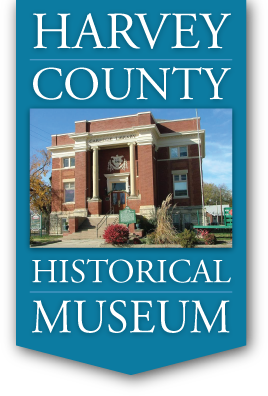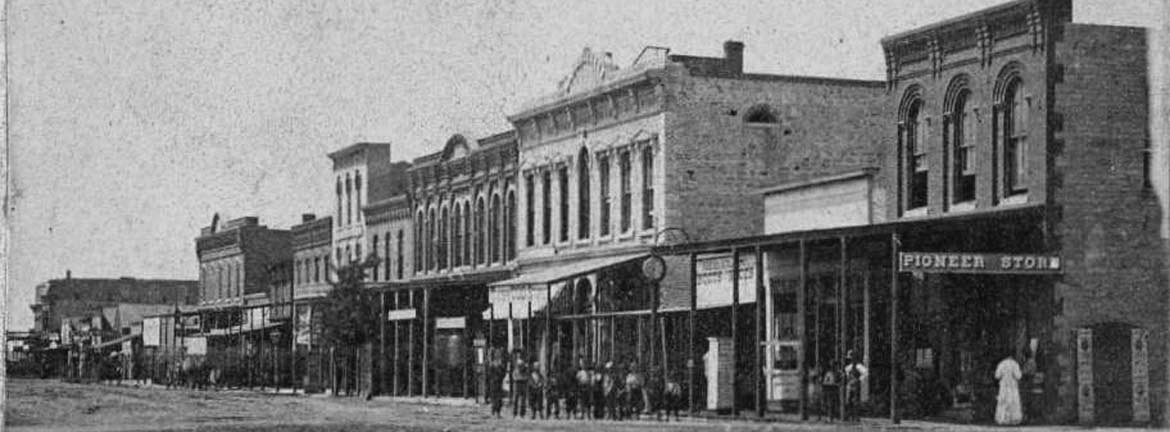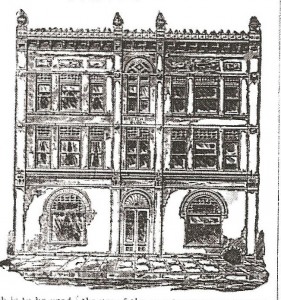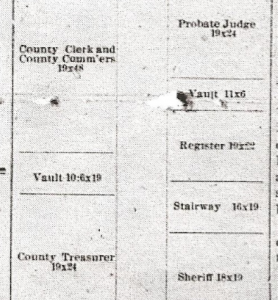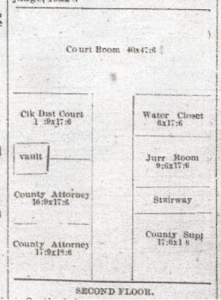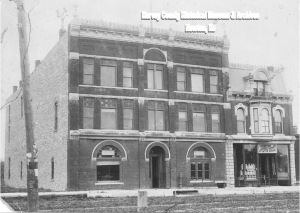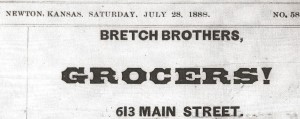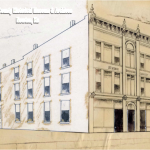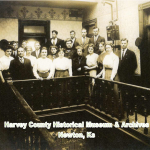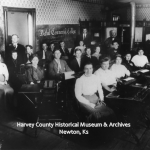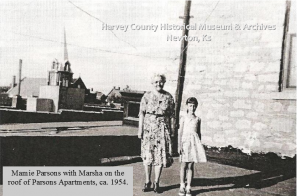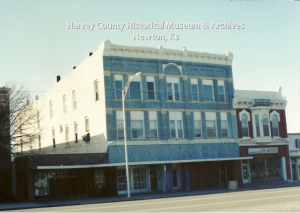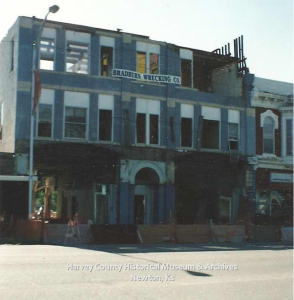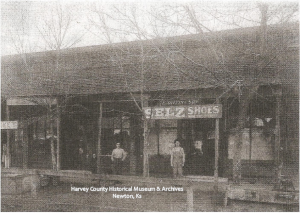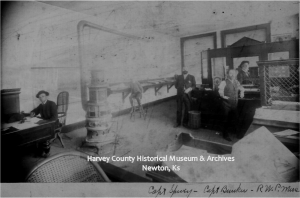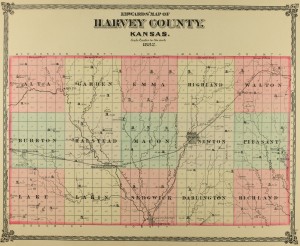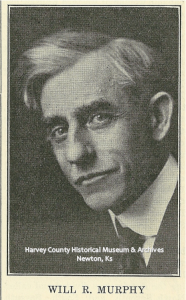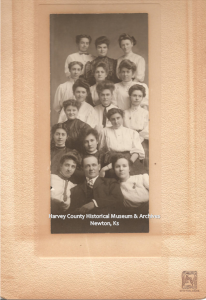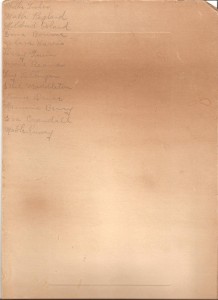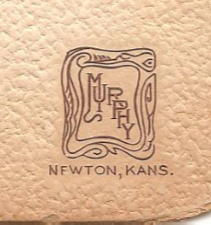by Kristine Schmucker, HCHM Curator
The current Harvey County Courthouse is 50 years old in 2015-2016. To mark the occasion, our exhibit, Fifty Years of Service: The Harvey County Courthouse will open March 21, 2015. This blog post will highlight some of the other buildings that have served as a courthouse over the years.
Do you know where the first Harvey County courthouse was located?
For most of us, the picture that comes to mind is of the 1906 structure, but before that . . . where was the courthouse located?
There have actually been several courthouse locations. The first place to house the “County Offices” was the Johnson Building located at the corner of Main and Broadway, but by 1873 the the offices were located in a building owned by B.C.Arnold on Main Street. From 1875-1880, the offices were located on the second floor of the Hamill Building at 513 Main. In the 1885 and 1887 City Directories, the “County Offices” were located at the corner of east Broadway and north Main in the Masonic Building. The County Jail was on Main between 7th and 8th.
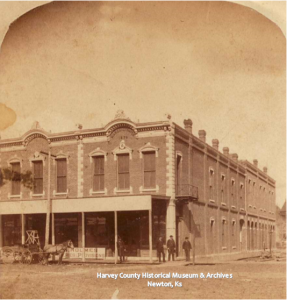
The Masonic Building, 700 N. Main, housed the courthouse from 1880-1888 and 1897-1906. Photo ca. 1880
A push was made to construct a courthouse in 1887. In November 1887, the bond issue for a new courthouse for Harvey County failed to pass.
The Bretch brothers, Samuel, William and John, were successful businessmen in Harvey County and later Sedgwick County. They proposed a solution to the need for a courthouse. They would construct a three story building that would serve as a courthouse.
The Newton Evening Kansan praised them for “coming to the rescue with a proposition to erect a suitable building which the county should lease for a courthouse for five years.”
The new building was designed by architect Willliam L. Ross.
A newspaper article from the July 28, 1888 Newton Evening Kansan described the new Harvey County Courthouse as “one of the most complete and convenient courthouses in the state.” The building cost around $30,000 and was “one of the best arranged buildings of its kind in the state.”
The first floor housed the treasurer’s office, the county clerk and the commissioners’ offices and a “double vault” on the left. On the right were the offices of the sheriff, register and probate judge.
A courtroom and related offices were located on the second floor.
For several years the “handsome building,” a “monument to the industry and enterprise of . . . two young men,” served as a courthouse for Harvey County.
The Bretch Building was the county courthouse until 1896. The offices then moved back to the second floor of the Masonic Building at the corner of Main & Broadway.
The Bretch Brothers continued to operate a wholesale and retail grocery business at the 811 location.
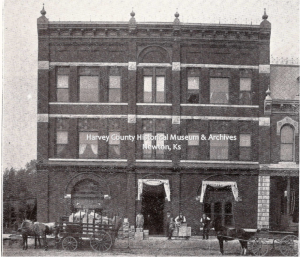
Bretch Brothers Wholesale & Retail Grocery , 811-813 Main, opened in 1881 from the Western Journal of Commerce, 1901.
Bethel Commercial College
The Bethel Commercial College was located on the third floor of the Bretch Building beginning in about 1913. Charles N. Parsons was the superintendent.
- Drawing of Bethel Commercial College later the Newton Business College by C.N. Parsons, n.d.
- Bretch Building Interior, 3rd floor. Students of the Bethel Commercial College.
- Students of the Bethel Commercial College in a classroom, C.N. Parsons instructor, 1911.
Newton Business College
In 1917, Parsons is listed as the principal of the Newton Business College located on the third floor of the Bretch Building, 811 Main, Newton.
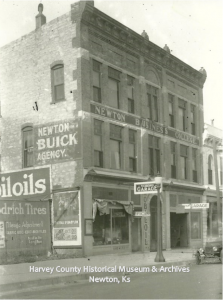
Newton Business College, Newton Buick Agency, Goodrich Tires, Nicodemus Garage, 811 -813 Main, Newton, 1917.
Parsons Apartments
The upper levels of the building were converted to apartments in the early 1920s. C.N. Parsons was the manager.
Sadly, this structure was found to be unsafe in the early 1990s and was torn down.
Sources:
- Newton Evening Kansan, 28 July 1888, “Harvey County’s Handsome New Court House.“
- Evening Kansan Republican 15 Feb. 1905, “Mrs. William L. Ross,” p. 4.
- Evening Kansan Republican 9 Feb. 1911, “William L Ross Passes Beyond,” p. 1
- Western Journal of Commerce, 1901.
- 50th Anniversary Ed. of the Newton Kansan 22 August 1922.
- Newton City Directories, 1885, 1887, 1902-1903.
- Voter Registration Book, 1882-1902, HCHM Archives.
- Western Journal of Commerce: Souvenir Edition, Newton Kansas,1901.
- Newton Kansan 50th Anniversary Edition, 22 August 1922.
- United States Federal Census: 1850, 1860, 1870, 1880, 1900, 1910.
